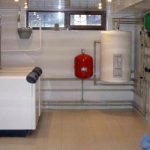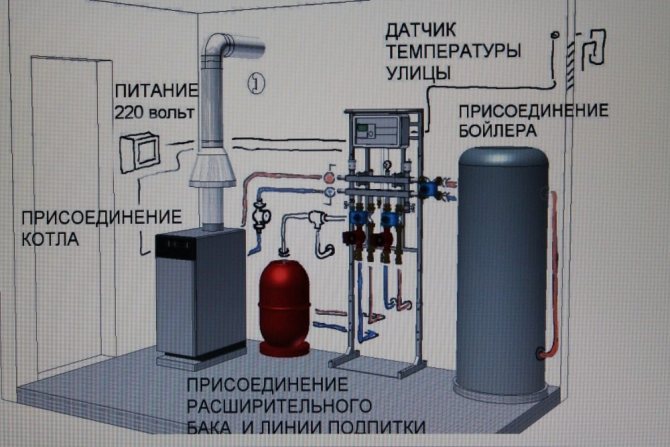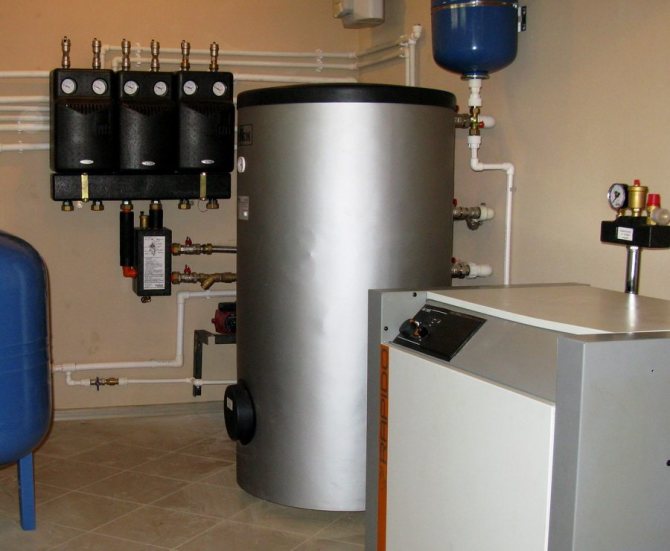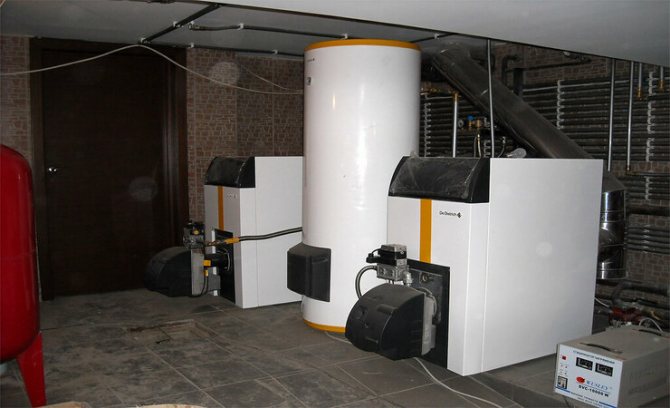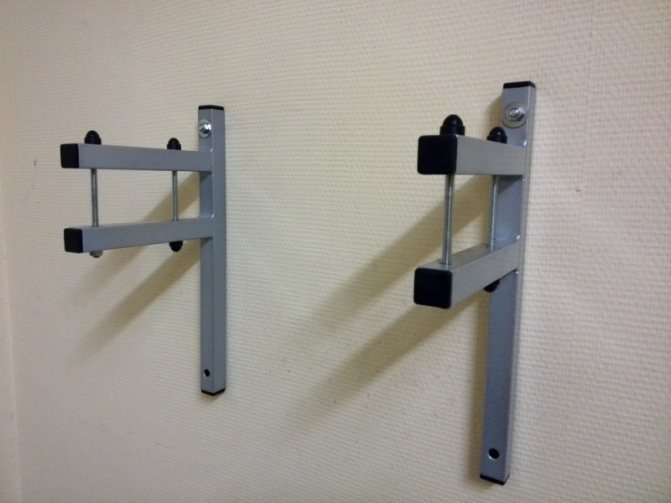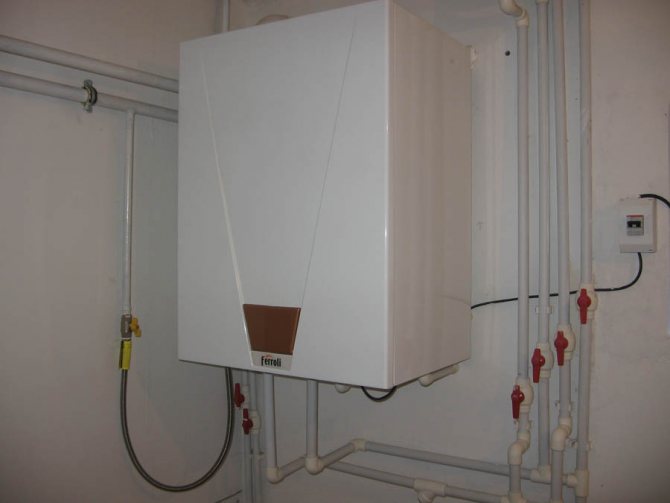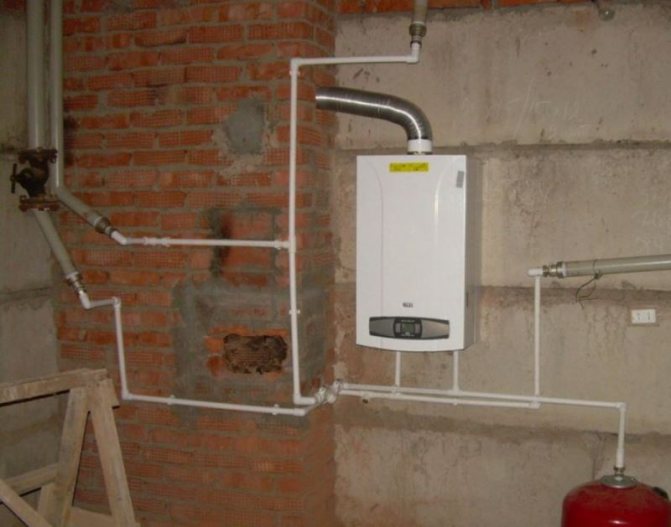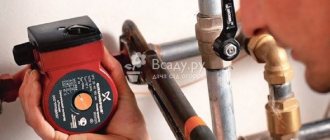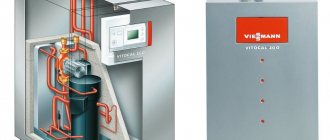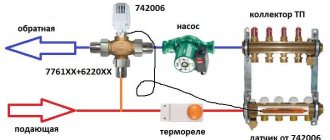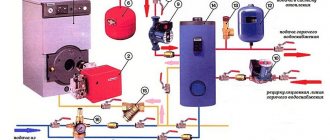Boiler room device in the basement
So it is possible or not
The question is often asked: "Is it possible to install a gas boiler in the basement?" The answer is unequivocal and categorical: you can. The only exceptions are systems that are supplied with liquefied petroleum gas (LPG) produced from oil.
The history of this issue stretches back to the time when the location of boiler rooms in the basement and basement floors was really prohibited due to the widespread use of LPG.
However, with the transition to natural gas and boilers with a closed firebox, this ban was lifted, and now up to four heating or water-heating gas boilers with a total capacity of up to 200 kW can be located in, as well as on the attics and roofs of single-family houses.
Important! This permit applies only to those boiler houses that are built and equipped in accordance with the requirements of GOST, SNiP and other regulatory documents and norms.
In general, taking into account the specifics of the Russian bureaucratic apparatus, it is better to draw up a project for the future boiler house and approve it in all instances in advance. This is preferable for the following reasons: if you come to the fire inspection or other supervisory authority for a permit for an already built and equipped boiler house, you will be blackmailed by the fact that it will have to be redone or completely closed.
This will make it possible to demand truly exorbitant bribes, because giving even a decent amount will be easier than rebuilding a boiler room or rebuilding it. On the other hand, if you bring a project for a future construction, then there will be nothing to blackmail you, an official can only make reasoned corrections and comments, after taking into account which he will have nothing to do but approve your project.
Requirements for the premises
In order to place a boiler room in a particular room, it must be brought into compliance with certain requirements.
Regardless of where exactly the room is located, it must meet the following parameters:
- Distance from (room height) should be at least 2 meters, optimal height - from 2.5 meters;
- The room must be separate, it is strictly forbidden to place equipment in adjacent and combined with living rooms;
- The area of the boiler room is taken at the rate of 4 square meters per one boiler, while the minimum distance from the front of the equipment to the opposite wall should not be less than one meter;
- The equipment must be provided with free access from all sides for normal and convenient maintenance and repair of all parts of the system;
- In the boiler room, windows should be provided to the street, the area of which is taken at the rate of 0.03 sq. meters per cubic meter of room volume, but not less than 0.25 sq. meters;
- The width of the doorway should not be less than 80 cm;
- The floor must be level and solid, made of non-combustible materials. It is best to make a cement-sand screed, which can then be covered with tiles or other waterproof and fireproof material;
- Wall and ceiling structures should be made of non-combustible materials, finishing - plaster or tiles. Near the firebox, wall coverings that can catch fire or deteriorate under the influence of high temperatures should be covered with special shields made of non-combustible materials with a heat-insulating gasket;
- The entrance door must have at the bottom or a gap between the curtain and the floor with an area of at least 0.02 sq. meters;
- The room must have supply and exhaust ventilation;
- It is better to restrict access to the boiler room to the circle of persons who are directly involved in the maintenance or repair of equipment. Penetration of children and unauthorized persons into the boiler room is unacceptable.
Important! All these requirements are dictated by objective reasons and are aimed at maintaining your safety and normal operating conditions for heating equipment. The cost of ignoring these rules can be too high, up to emergencies, accidents and fires.
If we talk about the volume of the room for the furnace, then it matters only for boilers with an open firebox. For units with a closed sealed firebox, the volume of the room is not standardized. By the way, most modern boilers have closed furnaces, but if your device is equipped with an open system, then the table will help you:
To determine the volume, it is enough to multiply the area of the room by the height of its ceilings. The thermal power of the equipment is always indicated in the technical documentation.
Communication requirements
For normal operation of the heating room, it must be equipped with all the necessary communications.
The premises must be supplied with gas, sewerage, heating, water supply and electricity that meet the following requirements:
- The electrical network must be single-phase, rated voltage - 220 V, maximum current - 20 A. Be sure to install an individual circuit breaker (gas station) and make grounding. The insulation on the wires must be reliable and meet the requirements of GOST;
- For each installed boiler, a shut-off unit is mounted on the gas main;
- The supplied water supply must be freely connected to the hot water supply systems of the house, as well as to the heating system;
- Water supply systems, boilers and chimneys, as well as ventilation systems must be able to drain condensate and residual moisture into the sewer. This is especially important for emergency water drain systems;
- All parameters of the supplied communications (water pressure, gas pressure in the mains) must strictly comply with state standards.
Important! Before purchasing and installing boiler equipment, you must make sure that the parameters of your communications meet the requirements that the manufacturer puts forward for these communications. Otherwise, your equipment will operate abnormally and may deteriorate quickly, and only normal use is eligible for warranty.
Boiler room in the basement of a private house requirements
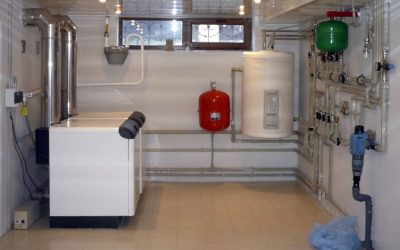
Placing a gas boiler in a residential area is not a good idea. This is an oversized piece of equipment and should only be accessed by adults who know how to handle it. Therefore, a boiler room in the basement is the best option.
In this video, we will consider how to equip a boiler in a private house:
Requirements for the room for the boiler room
The premises are subject to certain requirements, building codes and standards that must be followed. This is due to the need to ensure a high level of security and ease of management of all communications. First of all, it is necessary to restrict the access to the premises of persons who are not involved in the construction. This is especially true for children and pets.
Boiler room in the basement of a private house, basic requirements:
- The distance from floor to ceiling should be in the range of 200-260 cm.
- The boiler room should be located as far as possible from living quarters.
- It is prohibited to install gas equipment in a room next to the living room.
- The number of boilers is calculated according to the principle: 1 boiler per 4 m2 area.
- There must be a distance of 1 meter between the wall and the boiler.
- The main equipment should be installed in such a way that the person servicing it can approach from either side to perform maintenance and repairs. It is optimal that nothing is located closer than 1 meter.
- The room should have a window facing the street. Its size must be at least 0.25 m2.
- The door to the boiler room must provide a safe exit. The optimum width is at least 80 cm.
- A cement screed must be used as the flooring. This will provide sufficient strength, unlike linoleum, laminate and other combustible materials. You can put tiles or other special refractory material.
Equip the basement as a room for a heating boiler
- Walls with a ceiling should also be made of refractory material - tiles or plaster.
- To prevent the ignition of materials near the boiler, shields with insulation material should be used.
- At the entrance, at the door, you need to make a ventilation hole. As a rule, it is located at the bottom of the wall.
- The boiler room must have supply and exhaust ventilation.
All these requirements will ensure safety. They are created so that people can leave the premises in a timely manner in the event of an emergency. As a rule, the boiler room in the basement is a small room, so there are many conditions that can contribute to the initiation and spread of a fire. Everything must be done to minimize the risk.
Building regulations
In building codes and regulations (SNiP) there are provisions that govern the location of all items of equipment. According to them, a closed boiler must be installed in the basement. It captures air from the street, which simplifies construction and reduces the risk of fire.
In the paragraphs of building codes, in addition to the established distances of the room, there is a restriction for the installation of equipment. The gas boiler should be installed at a height of 80-160 cm. 100 cm should remain up to the ceiling. Basic guidelines: SNiP II-35-76, SNiP 2.04.14-88.
The norms of the installation rules available in SNiP are periodically changed. Therefore, before construction, you should contact competent heating engineers for advice. They will make adjustments if necessary and advise on how to install the equipment.
The choice of heating devices
Optimal system operation is impossible without the required communications for the equipment. Installing a boiler room in a private house is a complex process, for the implementation of which it is necessary to take care of the supply of gas, water supply, sewerage and electricity.
First of all, you need to take care of conducting a single-phase electrical network, which has a standard rated voltage and a maximum current of 20 A. Another important condition is high-quality wire insulation, grounding and installation of the machine.
If there is one boiler on the basement floor, then one shut-off unit will be sufficient. It is installed on the gas main. When installing two boilers for each unit, you will have to use a separate shut-off unit.
Care should be taken to connect the water supply to the general hot water supply and heating system. This will allow you to use the boiler room in case of need for other work
Condensation collects in the water supply system, ventilation, chimney and boiler, therefore it is necessary to use a device that removes excess moisture. This issue cannot be ignored, since state standards contain regulated indicators for boiler rooms in the basement.
Wall-hung boiler installation
There are wall and floor gas boilers for the basement of the house. Both have their own advantages and disadvantages.Most often, wall-mounted boilers are used, although they require a lot of labor for installation.
The main condition for fixing the boiler is a secure fixing. It is necessary to leave a space of at least 20 cm between the boiler and other equipment. An indent of 2-3 cm is required between the wall and the installation. The boiler can also be mounted above other available equipment.
The installation of a wall-mounted boiler should be started by collecting all the necessary elements: instructions, brackets, fasteners, pliers, screwdrivers and other tools. Boiler manufacturers are obliged to place a technical data plate on the equipment. They should be compared with those written in the instructions.
If the wall to which the boiler is mounted is made of wood or other material that is highly flammable, then it is necessary to use a heat-insulating material. Its thickness must be at least 3 mm.
The next step is the installation of the brackets. It is imperative to use dowels here. The instructions have a diagram according to which all actions should be performed. Next, you need to fix the strips on the boiler. Different manufacturers offer their own ways. It is necessary to act according to the instructions. In most cases, self-tapping screws are used.
Before hanging the boiler on the brackets, wash the pipes of the unit. For this, a jet of cold water is used. This eliminates the particles that enter the system when the equipment is created or transported.
The boiler is hung on the brackets using a special rail. This point is also prescribed in the instructions. After installing the equipment in place, you must make sure that it is in a horizontal position, without distortions.
To prevent the boiler from clogging up during operation, it is necessary to find a pipe leading to the heat exchanger and connect a filter element to it. There are ball valves on both sides of this filter element that allow the water to be shut off.
Wall-hung boiler installation
For those who decided to install the boiler with their own hands, we have compiled an instruction:
- Choosing a place for installation
... The distance from other devices should not be less than 20 centimeters, the distance between the boiler and the wall is taken from 30 to 50 mm, depending on the power (indicated in the instructions). The unit can be installed above other devices or a cascade, if there are several of them;
- Checking the complete set of equipment
... Find instructions, mounting template or installation diagram, wall brackets and fixing strips;
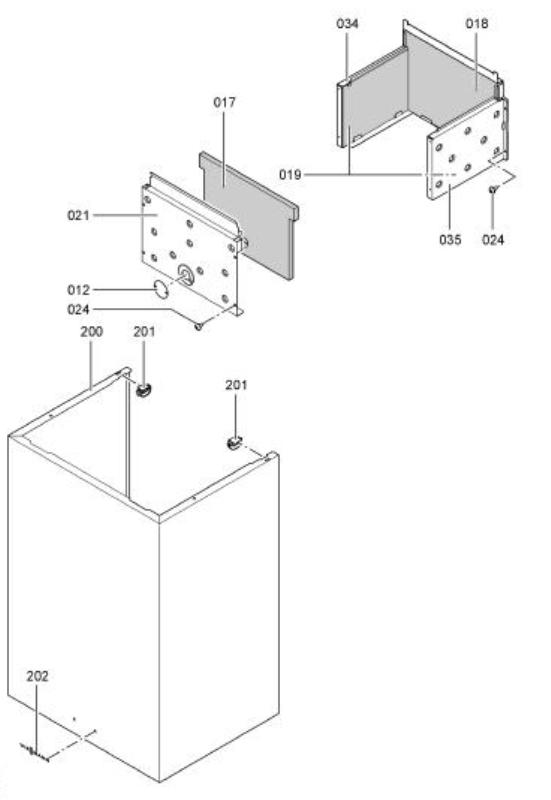

- On the inside of the front cover of the device we find an identification plate and compare all the technical characteristics of the device indicated in it with those stated on the package. After making sure of the correct configuration, we proceed with the installation;
- If the wall consists of wood or other combustible material, then a protective material with a thickness of at least 3 mm must be placed between it and the boiler, and the distance from the device to the wall must be at least 45 mm;
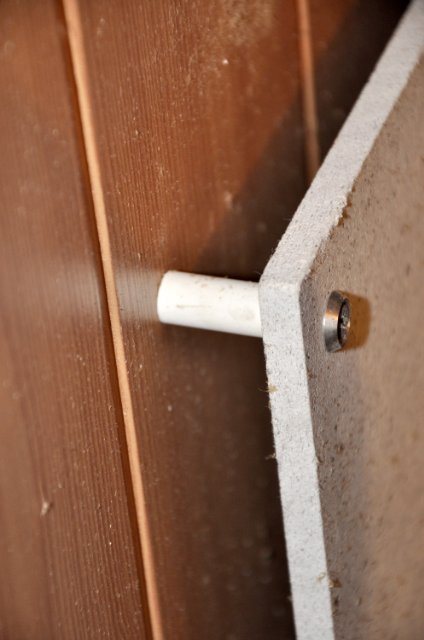

- We attach the brackets to the wall using dowels according to the scheme proposed by the manufacturer
... Boiler installation height - 0.8 - 1.6 m above floor level;
- We attach the mounting strips to the device.
They can be attached in different ways depending on the device model and manufacturer. Most often, bolts, screws or clamps are used;
- We rinse all pipes of the boiler and heating system with water to remove particles that have entered the system during the assembly and manufacture of the device;
- We hang the boiler with the mounting plate on the brackets in accordance with the fastening diagram
... We check the spatial position of the unit: it must be strictly horizontal, otherwise problems may arise in the work;
- We install an angle mesh filter on the water supply pipe to the heat exchanger, which will prevent clogging of the device. We equip the filter on both sides with ball valves for the convenience of repair and maintenance;
- The connection and commissioning of the unit is carried out by authorized employees of licensed organizations after checking the compliance of the equipment with accepted standards.
Important! Only competent representatives of state services should carry out the connection of gas pipes, as well as the inspection and start-up of equipment. Self-connection will not be considered correct even if it is fully compliant with the regulations.
Output
The installation of a boiler room in the basement of a residential building is a perfectly acceptable solution. The room is brought in accordance with the requirements of GOST and equipment is installed. For a more complete experience, we recommend the video in this article.
It has long been known that living quarters are not the best place to locate a gas boiler. In this case, the best solution seems to be to place this very gas boiler in the basement of the house. But what are the requirements for a boiler room? How to make sure that all SNIPs and state standards are observed?
Can the boiler be installed in the basement?
A gas boiler in the basement today is installed by many country homeowners. But there are also exceptions. So, the boiler should not be placed if the system operates on the basis of liquefied petroleum gas produced from oil. For many years, state standards prohibited boiler rooms from being located in the basement of a private house because LPG systems were used everywhere.
You can place the heating system in the basement. if you comply with the necessary requirements.
After the general transition to natural gas and special boilers took place, the requirements for the ban were lifted. Now, in the basement and on the basement floor, it is allowed to install no more than 4 gas boilers (water heating or heating type), the total capacity of which does not exceed 200 kW. If necessary, it is allowed to install a gas boiler even in attics.
Do not forget that before installing a gas boiler in your house, you need to approve a boiler room project. This must be done before you put the boiler on and start the system, because in the future, serious problems with the fire inspection are possible, where it may be necessary to rebuild or dismantle the boiler room. In addition, this approach will allow you to protect yourself from the fact that careless inspectors will demand a bribe. If the project is brought in advance, then the officials make certain adjustments to it without any problems, which must be taken into account and corrected in practice.
What should be the premises?
Having decided to make a boiler room on the basement of the house, it is necessary to take into account some of the requirements that are usually imposed on such premises. Regardless of the location of the future boiler room, the following standards and requirements apply:
- The height of the room should be more than 200 cm. The ideal option is 250 cm.
- The premises must be separated from the living rooms. Installation of gas equipment in a room adjacent to the living room is prohibited.
- 1 boiler (of any type) in the boiler room must have at least 4 m2 of space. In addition, the system should be located more than 1 m from the wall.
- It is necessary to provide full access to any part of the gas boiler from any side, so that, if necessary, it can be quickly turned off or repaired.
- The boiler room must have a window facing the street. The window size cannot be less than ¼ m2. The best option is 0.03 m2 per m3 of the room.
- The doorway in the boiler room must be comfortable and safe (at least 80 cm wide).
- The flooring must be made of cement screed in order for the floor to be solid. It is not recommended to lay linoleum, laminate and other combustible materials.The ideal option is tiling the floor and covering it with special refractory materials.
- Wall and ceiling surfaces should also be made of fireproof materials and finished with tiles or plaster. If there are materials near the firebox that can potentially burn or deteriorate under temperature, they must be covered with shields with insulation material.
- At the front door to the boiler room, it is required to provide for the presence of a ventilation hole, which is usually located at the very bottom of the door leaf.
- A mandatory requirement is a device in the boiler room ventilation of the supply and exhaust type.
- Also, the requirements for the installation of a boiler room on the basement provide for restricting access to the premises for persons who are not involved in repair work or maintenance of the equipment installed there. Access of children and pets to the boiler room is prohibited.
All the requirements that have been described above are designed, first of all, to ensure a high level of security for living in a private house. In addition, they allow you to operate the heating equipment in an optimal way. If these requirements are neglected, then the risks of an accident, fire and other emergencies are seriously increased. The boiler room, in most cases, is a small room in area, therefore, when conditions are favorable for the outbreak of fire, it appears there quite quickly.
Wall and floor coverings must be non-combustible.
The requirements for the volume of the boiler room only apply if the boiler has an open firebox. If the boiler's furnace is closed, then the volume of the boiler room can be any. More than 90% of modern boilers have a sealed furnace, however, if you are using an old unit, then the volume of the room should be as follows: 7.5 m3, 13.5 m3, 15 m3 with a heating capacity of boilers up to 30, 30-60 and 60-200 kW, respectively.
To determine the volume of the room, we multiply the area of the boiler room in the basement by the distance from floor to ceiling. In the manual for gas equipment, there is always an indication of the heat output of the boiler. A modern gas boiler in the basement of the house can be placed with any volume of the room. If the boiler room will be located in the basement, basement or ground floor of a building, it is necessary to provide for an exit to the street. In the event that it is supposed to make another entrance from the house, the door there must be finished with fire-fighting materials.
When the building has already been built, and it was not possible to find a suitable room for the boiler room, it is not recommended to allocate living rooms for these needs. The best option in this case is the construction of a separate building. At the same time, you need to take into account some of the norms and restrictions that have been described above.
Boiler room requirements
- What are the requirements for the boiler room if you plan to place a solid fuel boiler or stove equipped with a heat exchanger on the basement floor?
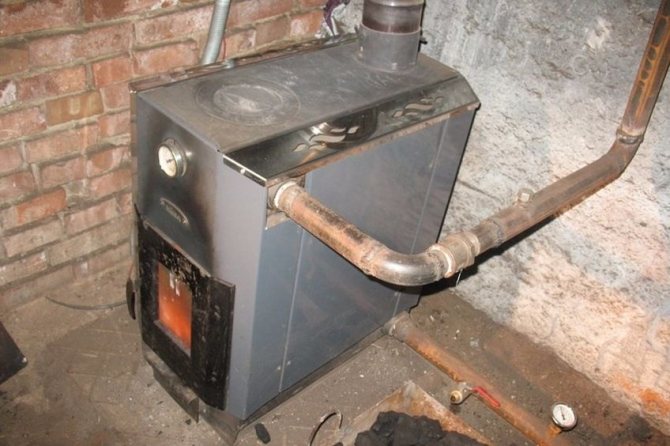

In the photo - a stove equipped with a heat exchanger in the basement of a cottage
The instructions for the installation of thermal equipment introduced in 1996 in paragraph 4.2 indicate that the capacity of a boiler or any other heat source when installed in a basement room should not exceed 350 kW.
Moreover:
- Ceiling height - 2.5 meters or higher;
- The fire resistance of the walls is at least 0.75 hours;
- The boiler room must have natural light. The area of the window (see Windows in the basement: dimensions, configuration and installation) must be at least 0.03 square meters per cubic meter of the room;
- The ventilation system must provide an exhaust in a volume that provides a complete air renewal 3 times per hour, and an inflow in the same volume, adjusted for the air consumption during fuel combustion.
Note: there are no restrictions on the area and volume of the boiler room when they are placed in the basement.The document only indicates that the room should provide easy access to the equipment located in it.
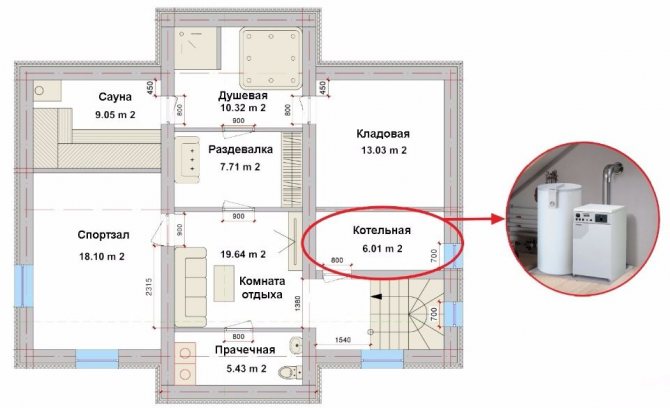

The dimensions of the boiler room in the basement are not regulated
- Are the requirements for the boiler room becoming more stringent if it is planned to install a gas boiler on the basement floor?
The answer can be found in paragraph 6.18 of SP 42-101-2003:
- The ceiling height with a gas equipment power of less than 60 kilowatts can be reduced to 2 meters, with a higher power its minimum value is 2.5 meters;
- Requirements for ventilation and for the area of windows completely coincide with those described above;


Light window in the basement gas boiler room
- The fire resistance of the enclosing walls should not be less than 45 minutes;
Reference: such fire resistance is provided, for example, by brickwork 25 centimeters thick (brick).
- With a gas equipment capacity of 150 kilowatts and above, the boiler room in the basement room must have a separate outlet.
If you plan to install a gas boiler in the basement, the requirements of SNiP 42-01-2002 will also have to be taken into account: regardless of the capacity of the equipment, the boiler room must have a gas pollution control system that can automatically shut off the gas supply.
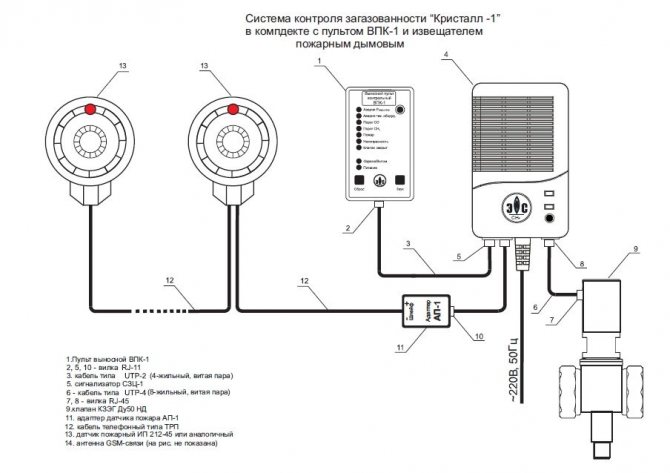

Gas control system device
Communications
The room equipped for the boiler room must have all the required communications for optimal operation of the system. The boiler room of a private house must fully meet fairly stringent requirements: it is necessary to bring not only gas and water supply there, but also a sewage system with electricity. In addition, when making communications, the following requirements should be observed:
- It is necessary to install a single-phase power network with a standard rated voltage and a maximum current of 20 A. Also, grounding and an automatic device must be installed. In addition, do not forget about high-quality insulation on the wires.
- If one boiler is installed, then the installation of one shut-off unit, which is installed on the gas main, is enough. When there are 2 or more boilers, each one needs to install its own shut-off unit.
- The water supply in the boiler room must work in the same system with the hot water supply of the building and the heating system. In this case, the boiler room becomes a room in which you can install not only a boiler, but also perform any work.
- In water supply systems, ventilation, as well as in chimneys and boilers, it is required to provide a device for eliminating condensate and other moisture. This is a very important point for an instant water drain system.
- State standards clearly regulate the communication indicators for boiler rooms on the basement floor, so it is advisable to familiarize yourself with them before starting work.
Features of doors that are used for the boiler room
If the boiler room is a separate room in the cottage, according to the standards, the door must be made of refractory material and withstand the fire for at least 15 minutes. As a rule, these are metal doors.
If the door from the boiler room goes directly to the street, then according to SNiP it should be “weakly reinforced”. This is based on the fact that during the blast wave, the door frame will be squeezed out, and the explosion will rush into the street, and not onto the walls of the building. Another advantage of such doors is the free gas outlet.
Usually, doors intended for boiler rooms have a grate at the bottom, allowing fresh air to flow into the room.
Wall-hung boiler installation
If you want to install a gas boiler for a private house with your own hands, then the first step is to choose the type of equipment: a floor-standing or wall-mounted boiler. Each of them has its own advantages and disadvantages.
Mounting the boiler on the wall should be as reliable as possible.
- Choosing a place for installation.It is necessary to provide for the moment that for other equipment the distance from the boiler wall should exceed 20 cm. In addition, a small indent of 30–50 mm will have to be made from the wall (depending on the boiler power). It is allowed to mount the boiler on the wall above other equipment located on the basement of the house if there are several units in the boiler room.
- Before installation, it is imperative to check whether all the necessary elements for work on site: installation project, instructions, mounting brackets, screws, etc.
- A plate with all the technical characteristics of the unit must be placed on the boiler lid. Before installation, it is necessary to check the indicated figures with those shown in the instructions and on the packaging. If everything matches, then you can start editing.
- If the walls on the basement of the house are made of wood or any other material that is exposed to fire, then a shield made of insulating material with a thickness of 3 mm or more must be installed between the wall and the unit. In addition, it is required to provide a distance from the boiler to the wall of 50 mm.
- Next, the brackets are attached. It is best to fix the brackets with dowels. The instructions always indicate the scheme according to which it is best to do this. It should be noted that the wall-mounted boiler is recommended, according to the rules, to be mounted at a height of 80–150 cm above the floor.
- Then the mounting strips are attached to the boiler. Fastening can be done in different ways (everything will depend on the specifics of the unit and the manufacturer). As a rule, ordinary bolts or self-tapping screws are used. In this case, there will be no incomprehensible details.
- Before hanging the boiler onto the brackets, it is necessary to rinse all the pipes of the unit with cold water in order to eliminate particles from them that have entered the system during the production and transportation of the equipment.
- The boiler must be hung on the pre-installed brackets using the fixing bar. This is done as indicated in the instructions provided by the manufacturer. The boiler must be placed horizontally, otherwise operational problems may occur.
- We find a pipe that supplies water to the heat exchanger, after which we mount a special filter on it to prevent the boiler from clogging up during operation. The filter on both sides must be equipped with ball valves, with the help of which, if necessary, you can quickly repair and service the equipment.
- Gas-type boilers are connected and put into operation only by licensed employees of the relevant companies, so this cannot be done on your own.
The boiler room of a country house can have several boilers at once, if, for example, the house is multi-storey or large, or heating of neighboring outbuildings is required (garage, barn, etc.). In this case, the requirements change slightly.
Installation of a floor-standing gas boiler in the basement of a cottage
The floor-standing boiler must be securely fixed to the floor of the room. To install it, it is recommended to make a concrete pad and place the boiler on it. An alternative to pouring a concrete pad can be the installation of a floor frame for a gas boiler.
The boiler must be installed strictly horizontally: the accuracy of the installation must be checked with a level. Some models of gas boilers are equipped with comfortable screw feet that allow you to accurately install the unit even on an uneven surface.
After that, a filter should be installed in the water pipe supplying water to the boiler heat exchanger to prevent impurities and particles from entering the system along with water. In addition, the water pipe must be equipped with a tap to shut off the water supply to the heat exchanger.
When installing a floor-standing gas boiler, it must be easily accessible. This means that such a boiler cannot be installed close to a wall.
Connecting communications (chimney, supply and outlet water pipes) to a gas boiler is a crucial stage of installation. After completing the installation, it is imperative to check the tightness of all units and connections. It is forbidden to connect to the gas boiler independently: this must be done by a specialist of the relevant state organization.
Floor standing boiler installation
Before starting the installation of the unit, it is required to arrange a foundation cushion or support frame for it. The boiler room in the basement, by and large, can be finished as you like. In addition, at the same time, a place is being prepared for connecting the pipeline and chimney.
If your experience is not enough to carry out installation work, trust the specialists.
- The boiler is being installed in a previously prepared place. Many units are equipped with comfortable screw feet, with which it is necessary to set the boiler horizontally.
- After a simple installation of the boiler, it is necessary to connect it to the return and supply pipes, which will lead to the circulation system of the unit. If the gas boiler is double-circuit, then it is necessary to bring a water pipe to the heat exchanger and perform flexible piping of the system. In addition, a cleaning filter must be installed on the return pipe to prevent rust from entering the equipment.
- Further, the boiler is connected to the gas supply system and the chimney. In most cases, these works are performed by professionals, and not by their own hands, because at this stage there are many technological features of the equipment that must be foreseen during installation.
- As soon as all installation work is completed, it is recommended to once again check the tightness of all seams and joints of the boiler. Usually a soapy solution is used for this, which is applied to the joints.
As in the case of a wall-mounted boiler, all connection and commissioning work should only be carried out by professionals. This is the guarantee that all the necessary requirements will be met.
Svarog (Builderclub expert)
Hello. There is SNiP 42-01-2002 "GAS DISTRIBUTION SYSTEMS" according to p. 7.1
"It is prohibited to place gas-using equipment (natural gas and LPG) in the premises of the basement and basement floors of buildings (except for single-family and blocked residential buildings), if the possibility of such placement is not regulated by the relevant building codes and regulations." It's easier if the house is private and for 1-2 families, then you can. That's just in the old SNiP 2.04.08-87 * "Gas supply" there were additional requirements for the premises for the installation of boilers, where they were transferred now - I do not know, but I advise you to withstand them, since the inspection authorities still actively use it:
"P. 6.29. When installing in the kitchen a gas stove and a storage water heater, a gas stove and a heating boiler or heating device, as well as a gas stove with built-in devices for heating water (heating, hot water supply), the volume of the kitchen should be 6 m 3 more than the volume provided for in cl. 6.29.
6.42. The room intended for the placement of a gas water heater, as well as a heating boiler or heating apparatus, the removal of combustion products from which is provided in the chimney, must have a height of at least 2 m. The volume of the room must be at least 7.5 m 3 when installing one device and not less than 13.5 m 3 when installing two heaters.
6.43. The kitchen or rooms where boilers, appliances and gas water heaters are installed must have a ventilation duct. For air flow, a grate or a gap between the door and the floor with a free cross-section of at least 0.02 m 2 should be provided in the lower part of the door or wall opening into the adjacent room.
6.44.It is not allowed to place all gas appliances in basement floors (in basements), and in case of LPG gas supply - in basement and basement floors of buildings of any purpose.
Note. The requirements of this paragraph do not apply to residential buildings owned by citizens on the basis of personal property rights, if the basements of these houses have natural lighting, and they are supplied with gas from natural gas.
6.29. The installation of gas stoves in residential buildings should be provided in kitchens with a height of at least 2.2 m, with a window with a vent (transom), an exhaust ventilation duct and natural lighting. At the same time, the internal volume of kitchen premises should be, m 3, not less: for a gas stove with two burners ... 8 m 3, for a gas stove with three burners ... 12 m 3, for a gas stove with four burners ... 15 m 3.
6.31. If it is impossible to fulfill these requirements, the installation of gas stoves in the premises can be allowed in each specific case in agreement with the local sanitary inspection authority.
6.35. It is not allowed to provide for the installation of more than two storage water heaters or two small-sized heating boilers or two other heating devices in one room. "
For the height of the gasket and the supply, see SNiP 42-01-2002 "GAS DISTRIBUTION SYSTEMS" section 5 "External gas pipelines".
to answer
Today, many low-rise construction companies prefer to build cottages with a basement. This option is advisable, as it can help to solve some functional tasks. Here you can equip a garage, laundry, boiler room, sauna, swimming pool and much more.
The question of where to equip a boiler room for heating a private house is very relevant. If it is located in the basement floor, then this frees from the need to build a separate room for these purposes. Another advantage of this location of the boiler room will be that there will be no unnecessary heat loss from the pipes going to the house when arranging the boiler room in a separate building.
However, the placement of a boiler room in the basement is possible only if the allocated room meets certain requirements:
- a supply and exhaust ventilation system must be installed;
- ceilings must be at least 2.5 meters;
- partitions of the room must be made of fire-resistant material;
- the volume of the room must be at least 15 cubic meters. m .;
- there must be a separate direct exit to the outside;
- free access to all boiler room equipment must be ensured.
Is it possible or not
- Is it allowed to place the boiler room in the basement?
Yes. SNiP 2-35-76, in force to this day, directly indicates that it is allowed to design built-in boiler rooms in the veins of houses, provided that they heat water to a temperature not higher than 115 ° C.
- Is it possible to place gas boilers in the basement?
In the case of a single-family house, yes. It does not contradict the above excerpt from SNiP: the temperature of the coolant at the boiler outlet is usually kept within 70-80 degrees.
Nuance: according to the text of the same SNiP, heating equipment on gas or on liquid fuel cannot be used in the basement with a flash point (the minimum temperature at which substance vapors can flare up in the air upon contact with an ignition source) below +45 degrees. Natural gas has a flash point of -187.8 ° C. However, this restriction does not apply to basements.
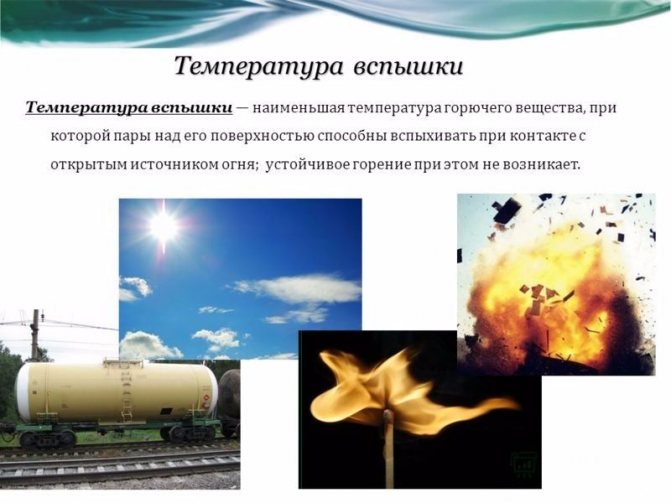

Definition of the concept of flash point
Please note that we are talking only and exclusively about private houses. Another SNiP - numbered 42-01-2002 - explicitly prohibits the placement of gas-powered equipment in the basement and basement floors of buildings, with the exception of blocked (adjoining low-rise) and single-family houses.
